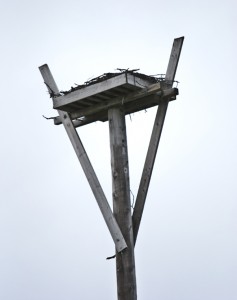By Ashliegh Gehl
 [1]
[1]BELLEVILLE, On. (05/19/11) An empty osprey nest sits atop a hydro pole in Zwicks Park. Photo by Ashliegh Gehl
Put the binoculars down, bird watching has gone digital.
The Bay of Quinte Remedial Action Plan is giving a whole new meaning to bird watching. It’s called the osprey cam, a 24-hour real time insight into the nest life of an osprey pair.
Sarah Midlane-Jones, spokesperson for the Bay of Quinte Remedial Action Plan, says the ospreys called Quinte home decades ago and have been making their way back over the years.
“It’s a success story for the Bay of Quinte. It shows that the habitat and the ecosystem are healthy. There’s a diverse, abundant fish population.”
Local bird enthusiasts are glad the black-winged birds are back.
“They’re tickled. They’re absolutely thrilled,” said Midlane-Jones. “These birds are hugely popular with people. People just seemed to be fascinated with them. They’re a magnificent animal. They’ve got over a six-foot wingspan. When you see one of those flying overhead it’s hard not to notice it.”
Next week the osprey cam will get more exciting once the first egg hatches.
“Right now she’s sitting on her eggs,” said Midlane-Jones who suspects three eggs are in the nest. “Well, we think there’s three. We had to go up and adjust the camera and the people that went up told us that there were three eggs. So, we haven’t exactly seen them yet.”
The first egg was laid Easter Friday and the others were laid one or two days a part. The eggs need 35 to 40 days to incubate. The first egg laid will be the first to hatch.
“So sometime between May 24 and May 29 the first one should hatch,” said Midlane-Jones. “It’s really cool.”
Right now the female stands post, sitting on the eggs. The male will take his turn when its time for her to fish. Once the birds are born the pair take turns bringing fish to the nest.
Local nature columnist Terry Sprague is known as Quinte’s bird guru.
Sprague says the local osprey population declined drastically decades ago due to DDT, a chemical pesticide used widely in the 1950s and 60s.
“DDT residues, particularly the metabolite DDE, adversely affected the estrogen hormone, which controls calcium levels and eggshell thickness, resulting in thinner shells and broken eggs,” he said. “Because fewer young were being produced successfully, the osprey numbers declined dramatically.”
The ban of DDT in the 70s and the introduction of artificial nest platforms are the two main reasons ospreys have retuned to the Quinte region, said Sprague.
He spotted the first osprey at Prince Edward Point on September 6, 1970, and over the years, the sightings have become more common.
The boxed nest on the osprey cam is a familiar sight in the Quinte region. The Remedial Action plan team and Hydro One built these boxes.
Ospreys choose hydro poles due to the crossed arms and the base to hold the nest.
“Much like extended tree branches would do,” said Sprague. “Similarly, they are also nesting on light standards in ball parks where the huge floodlights and the arms on which they are attached provide a nice cradle for the nest.”
Nests have also been found on maintenance platforms on communication towers, said Sprague.
The higher the nest, the safer it is. It provides a convenient lookout of potential dangers.
The osprey cam can be viewed at http://www.bqrap.ca